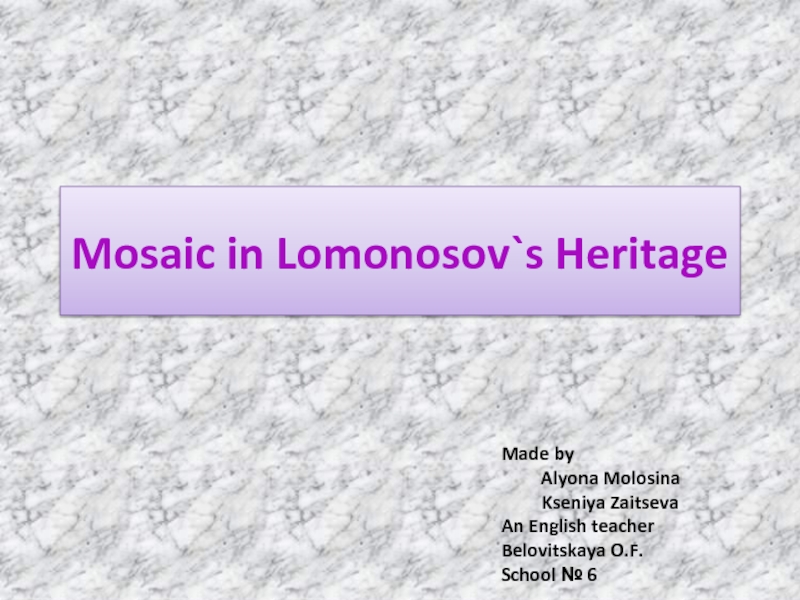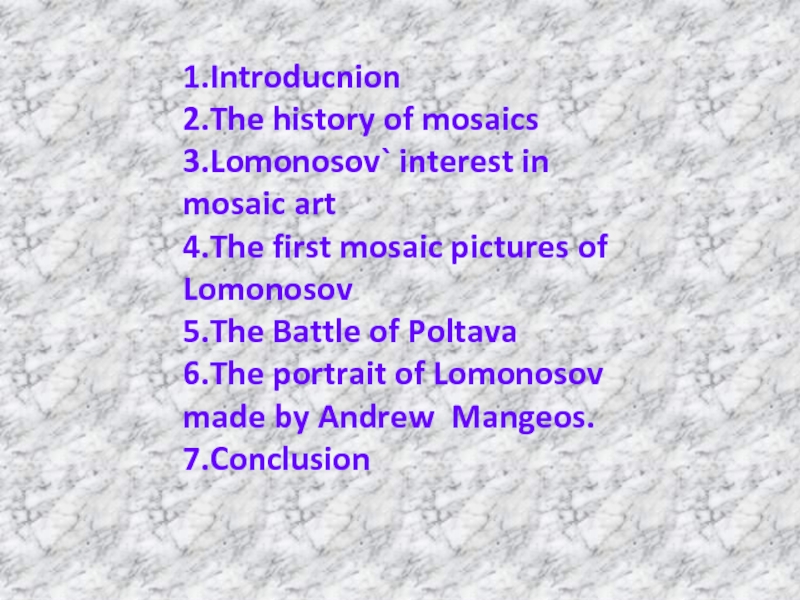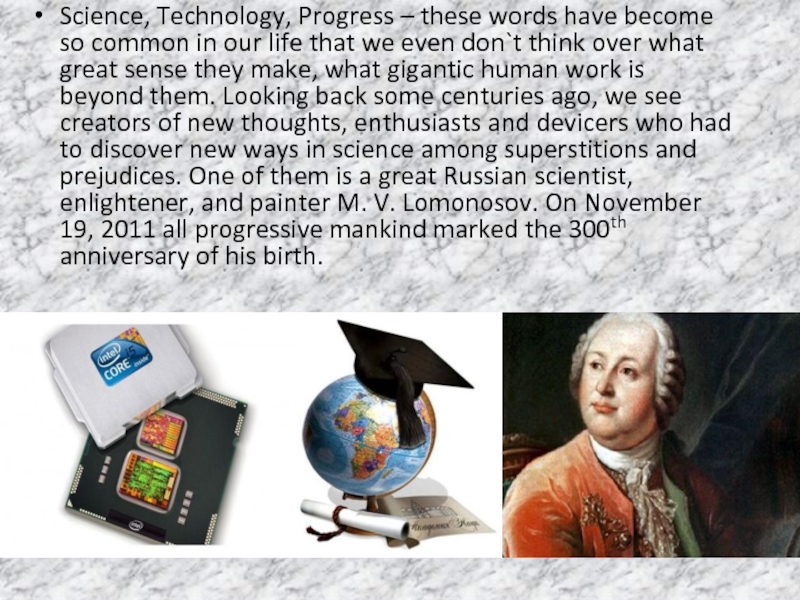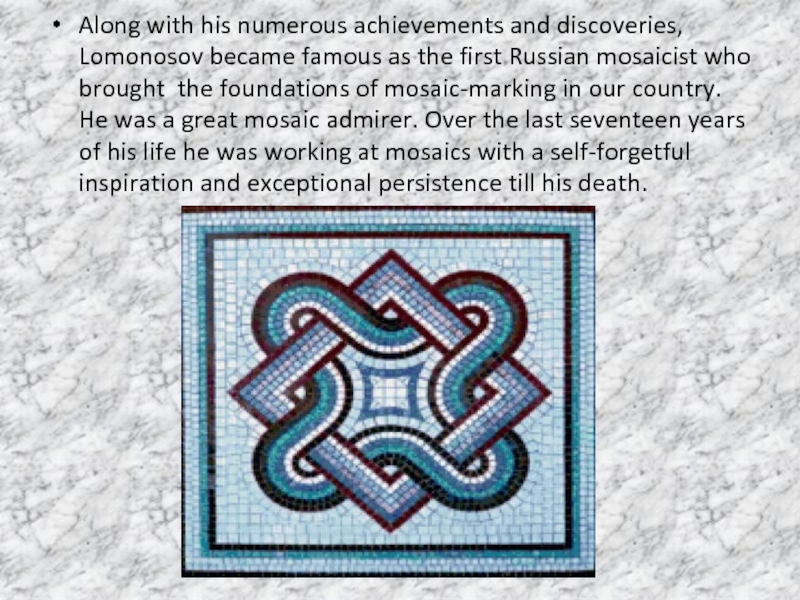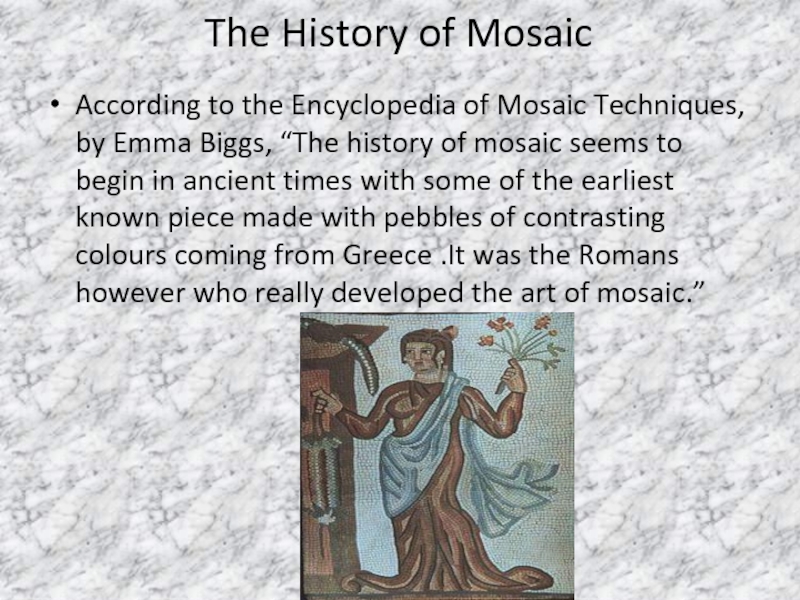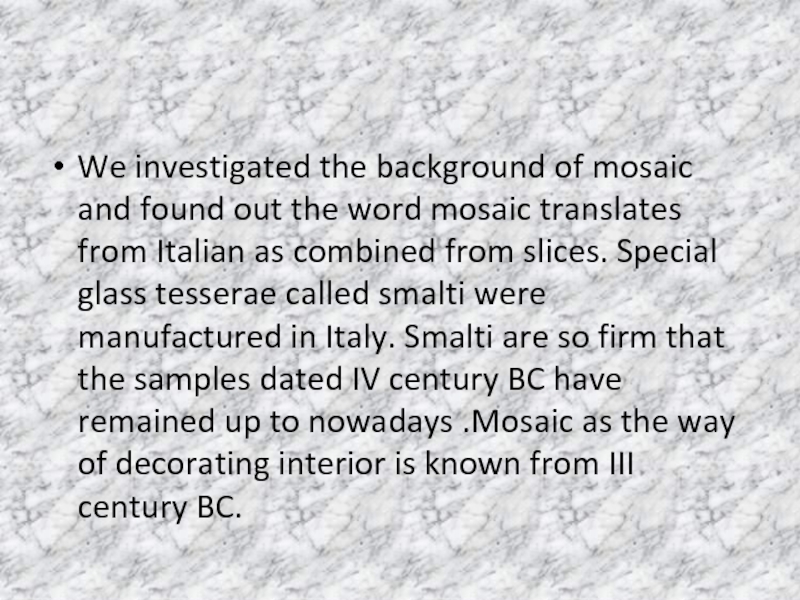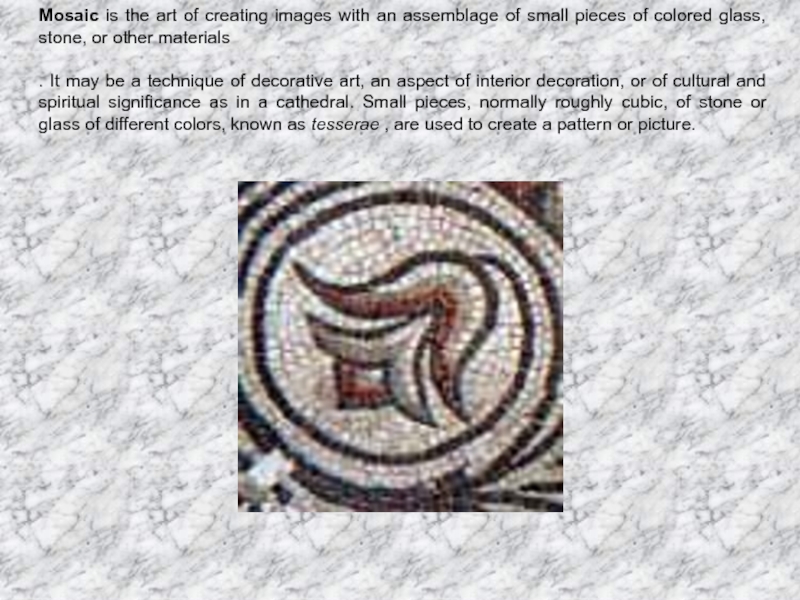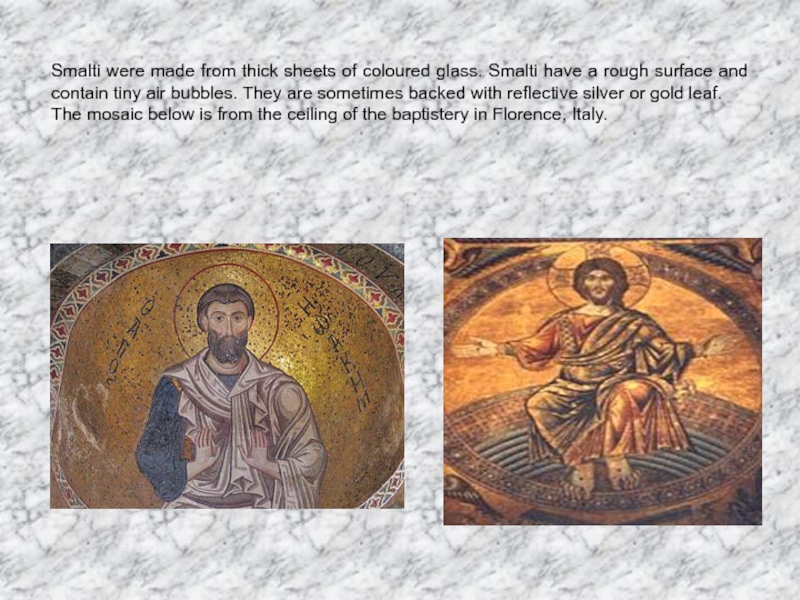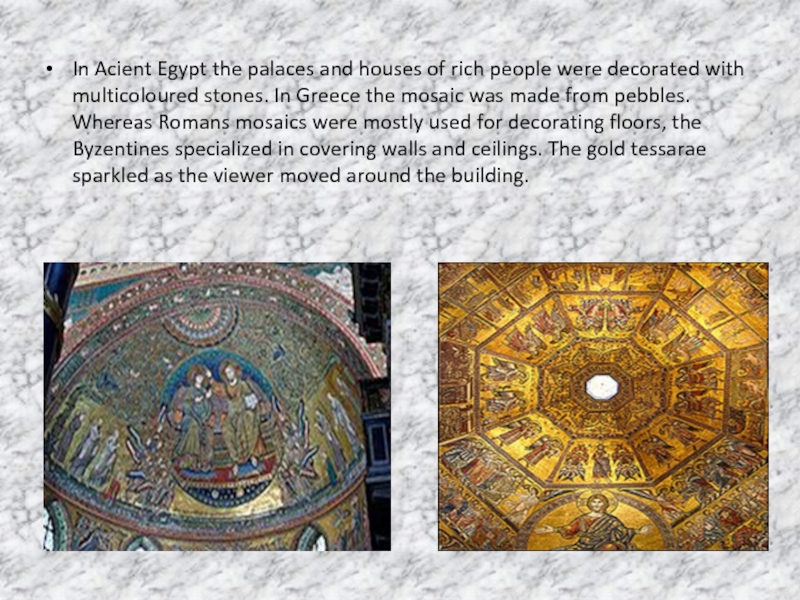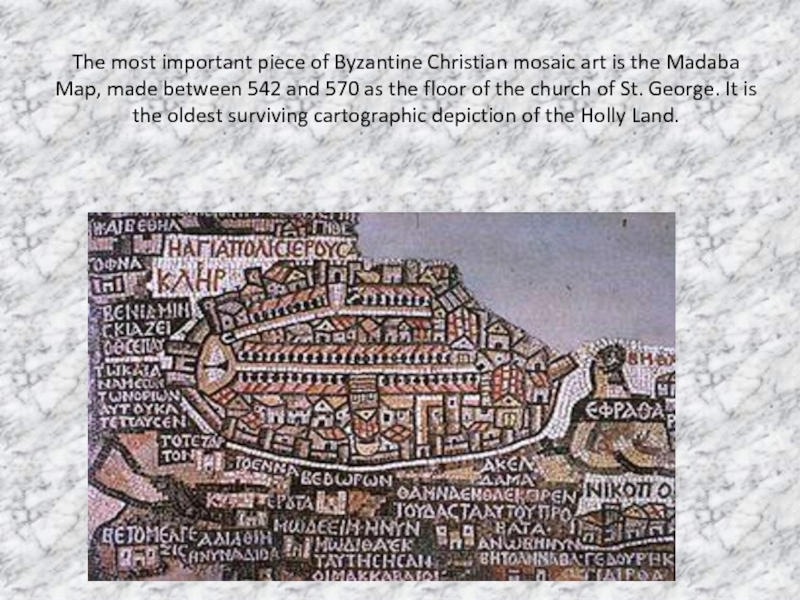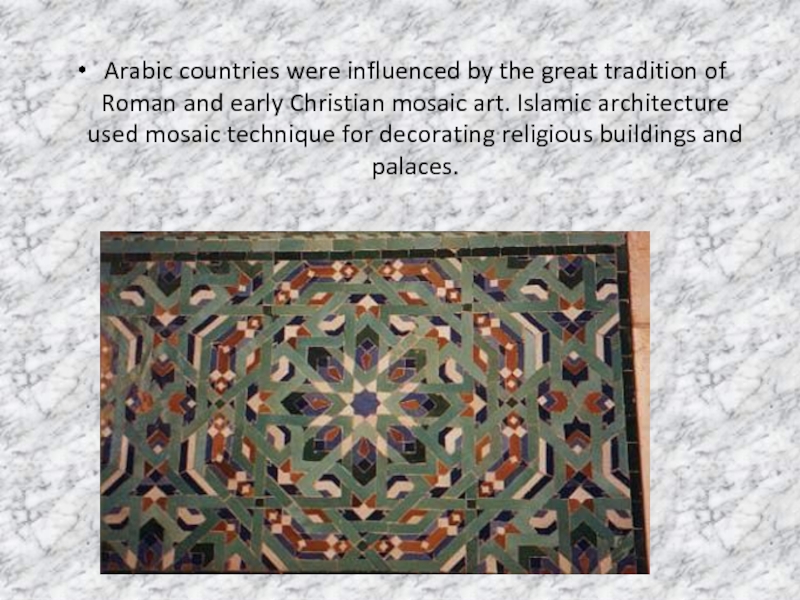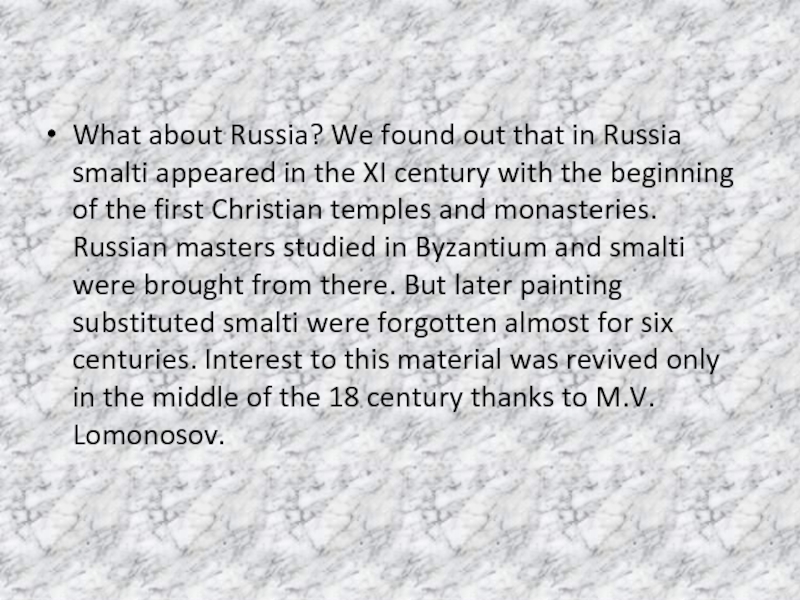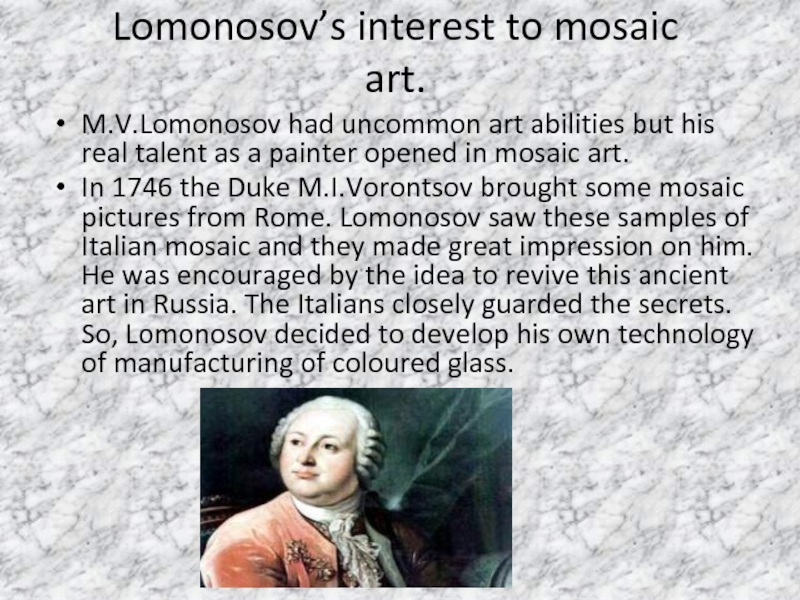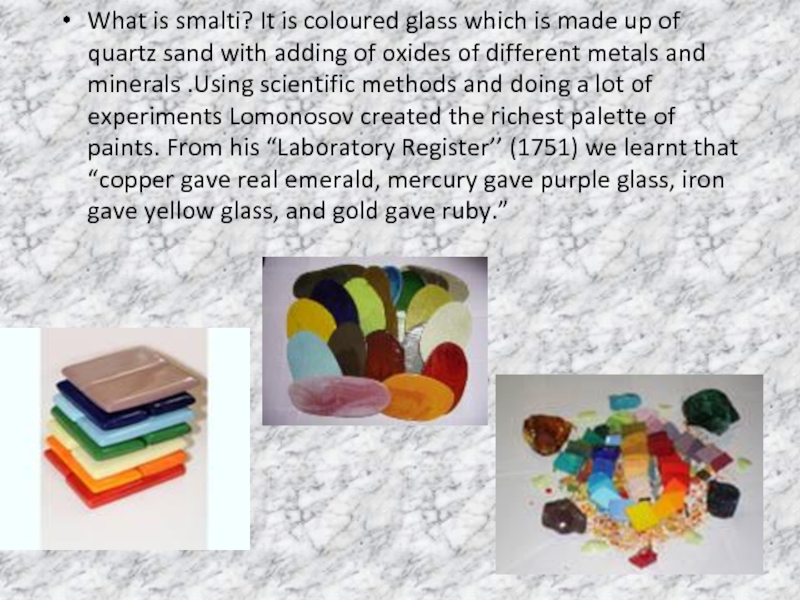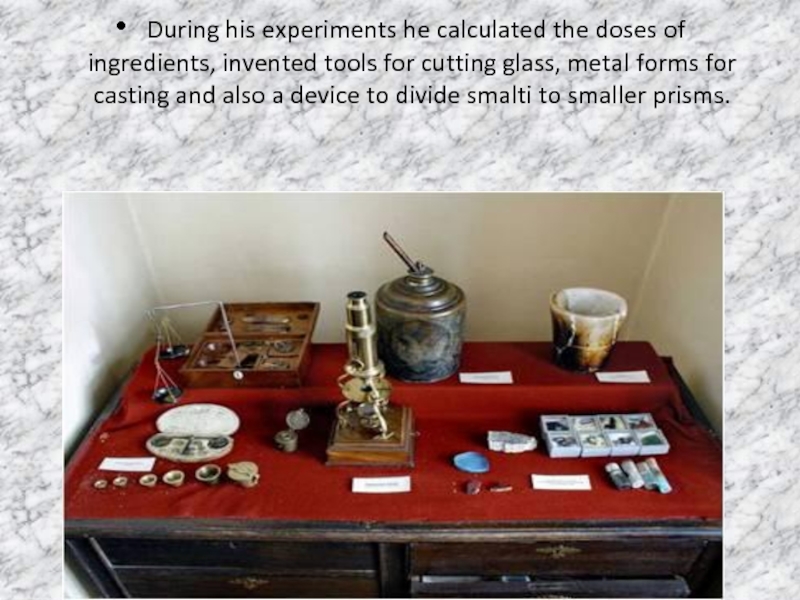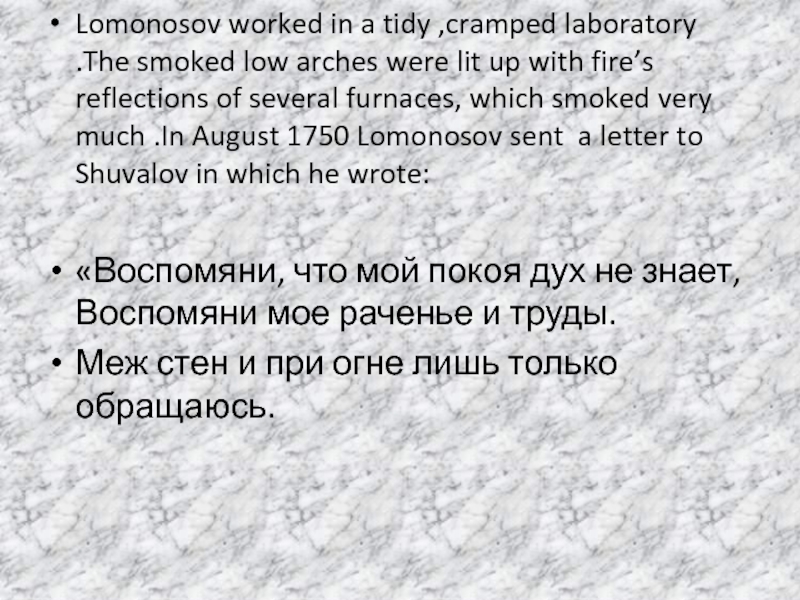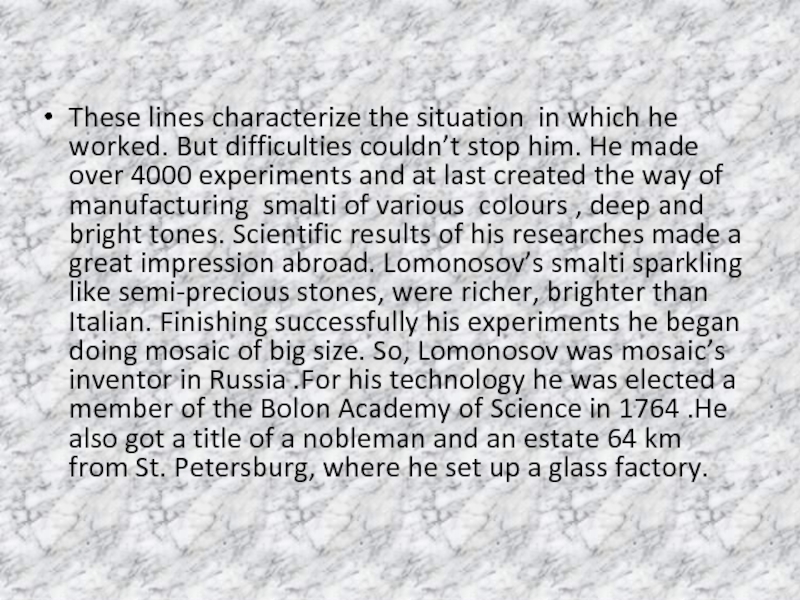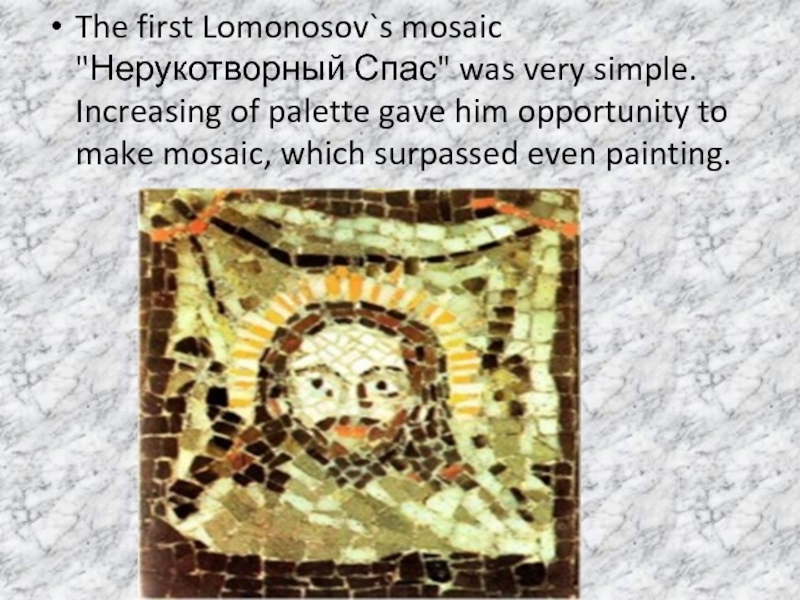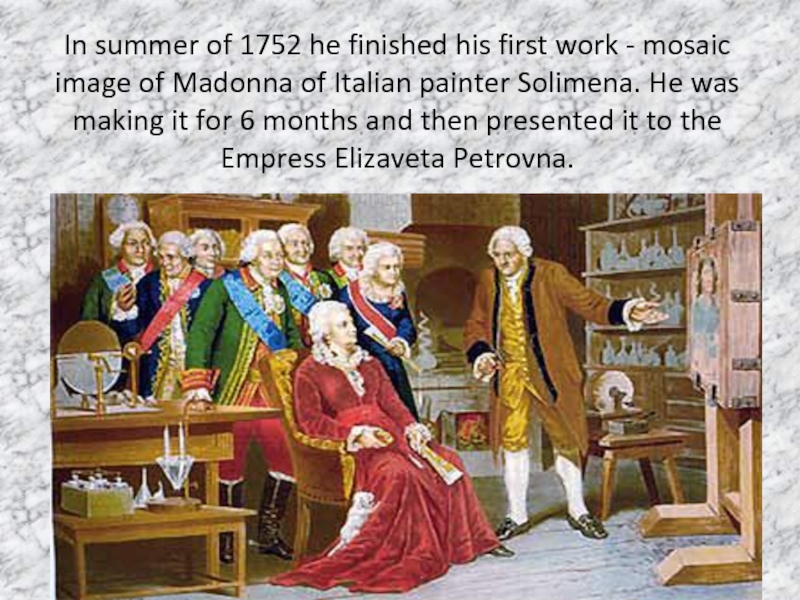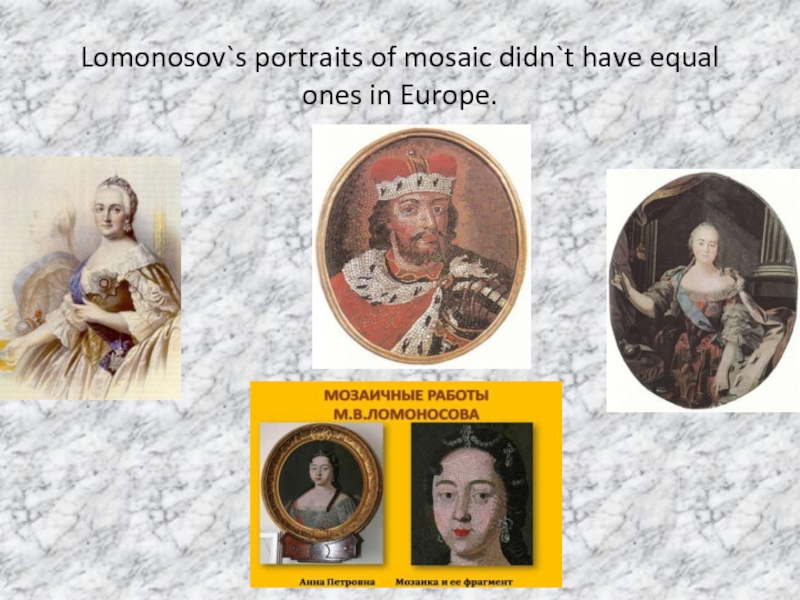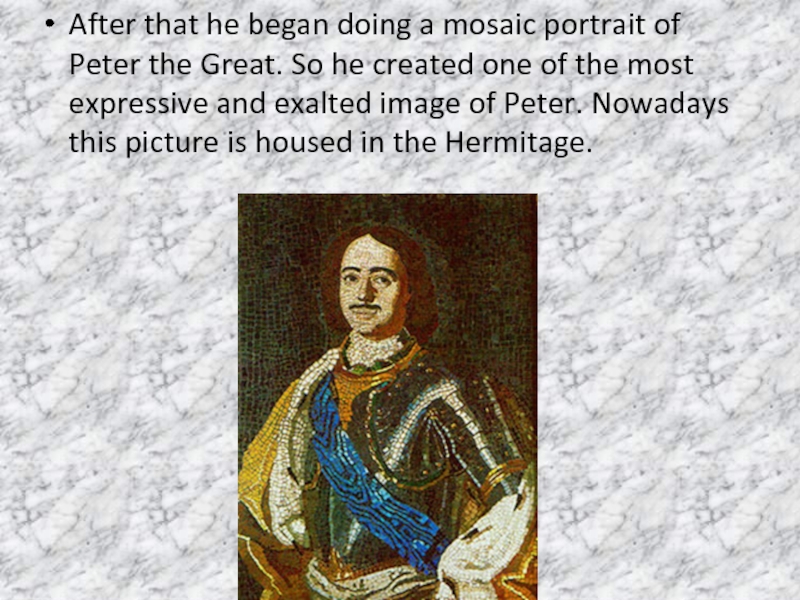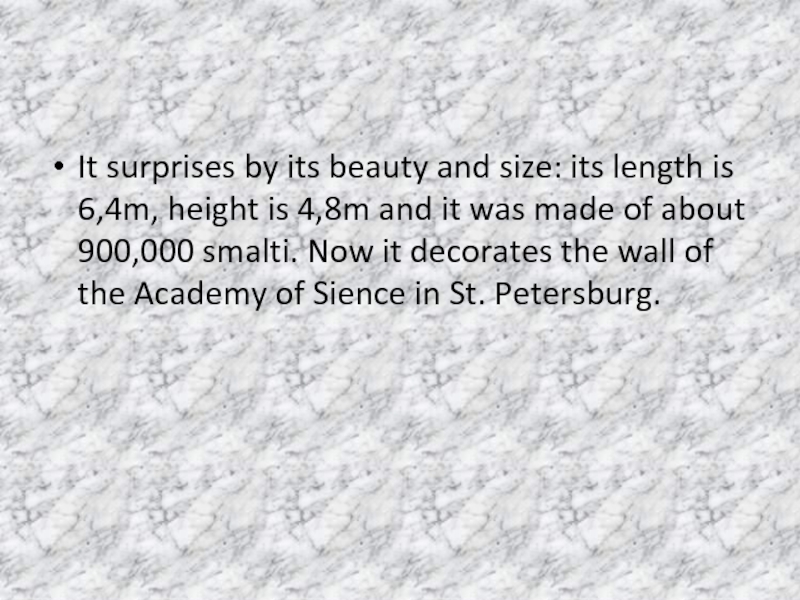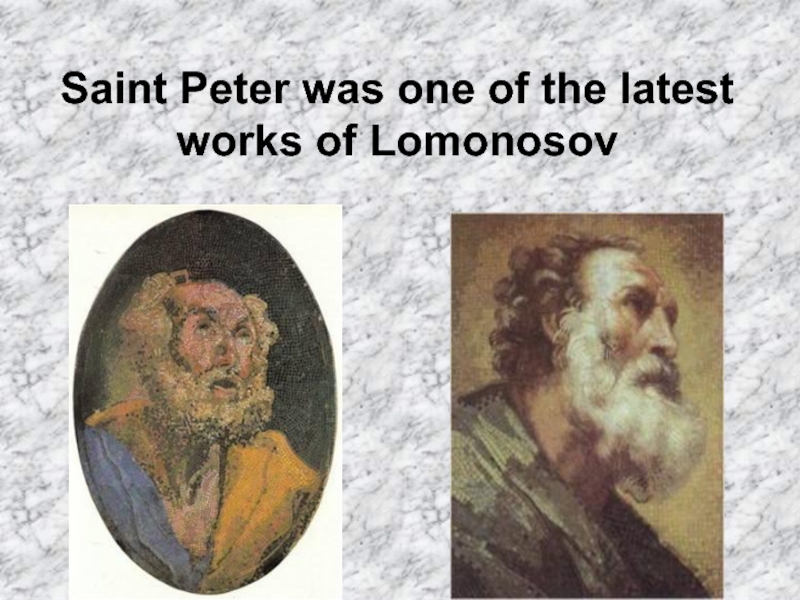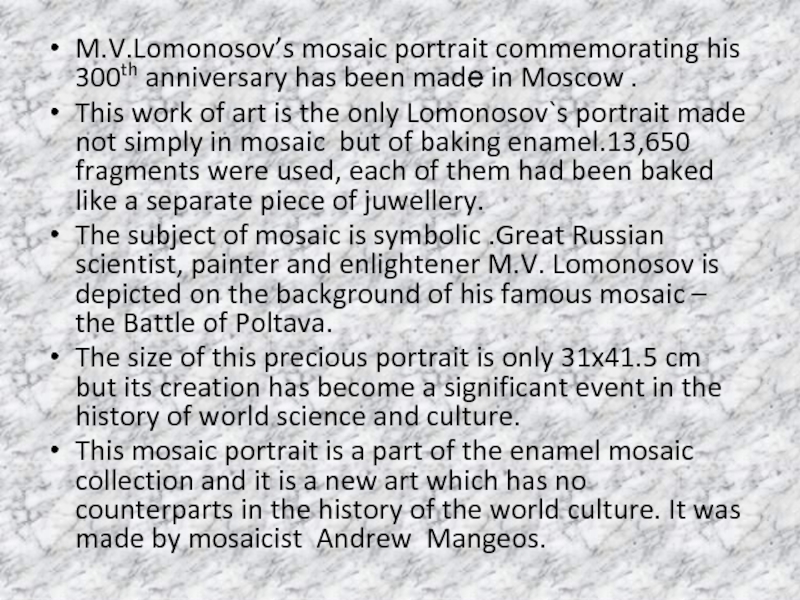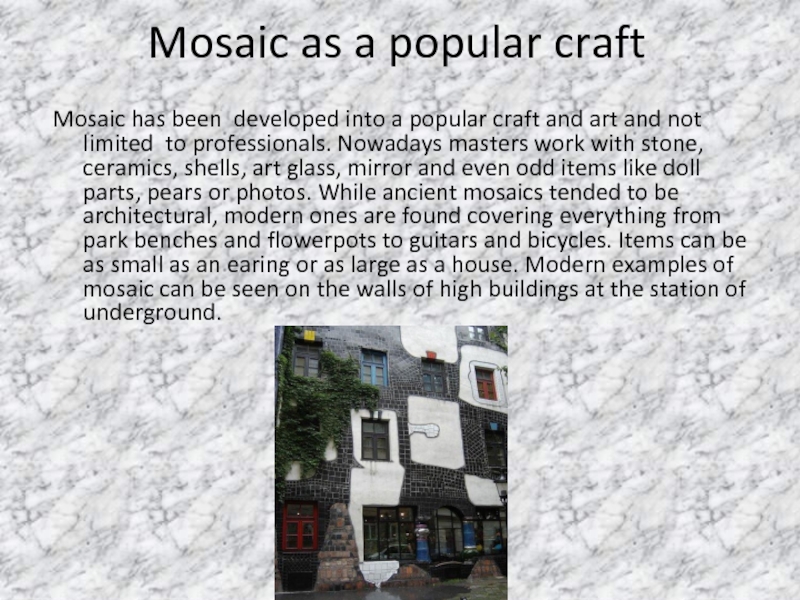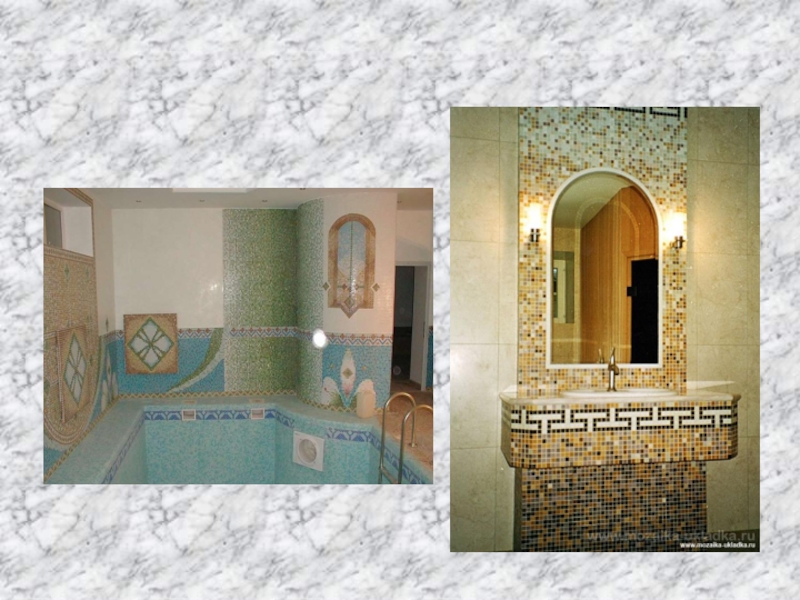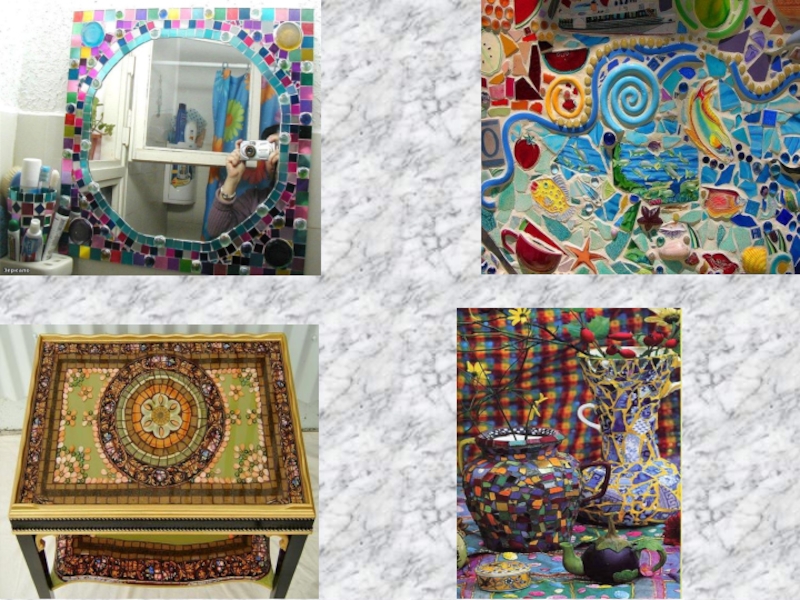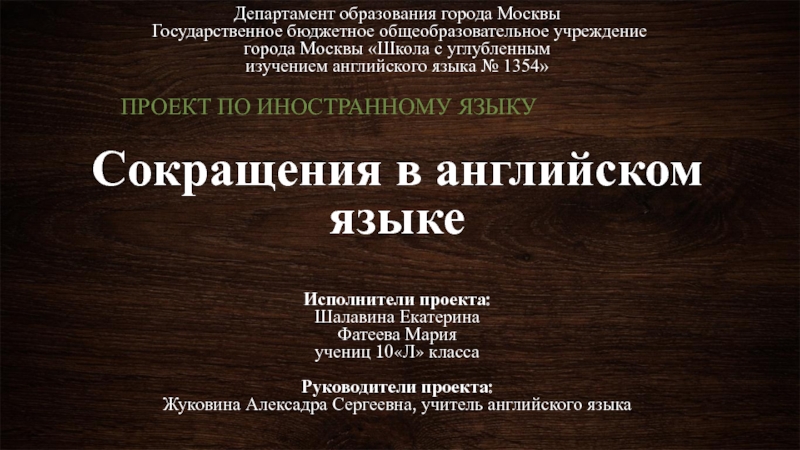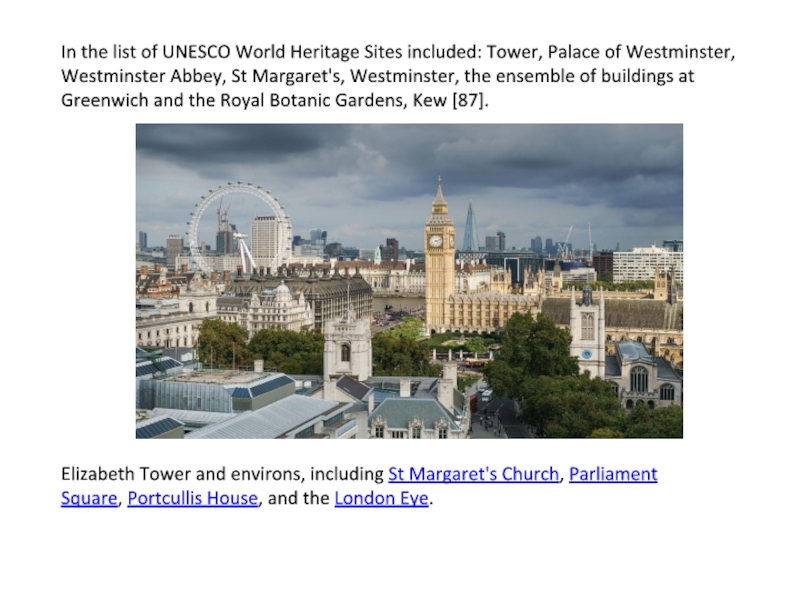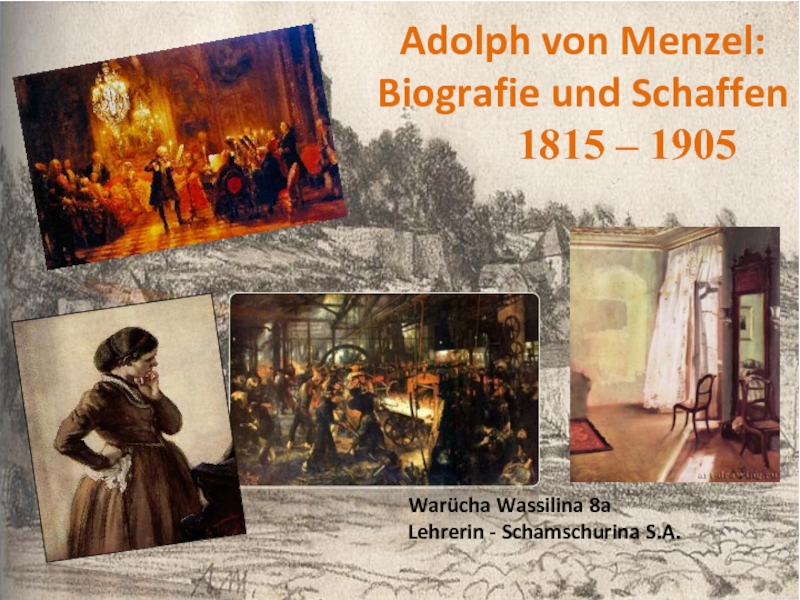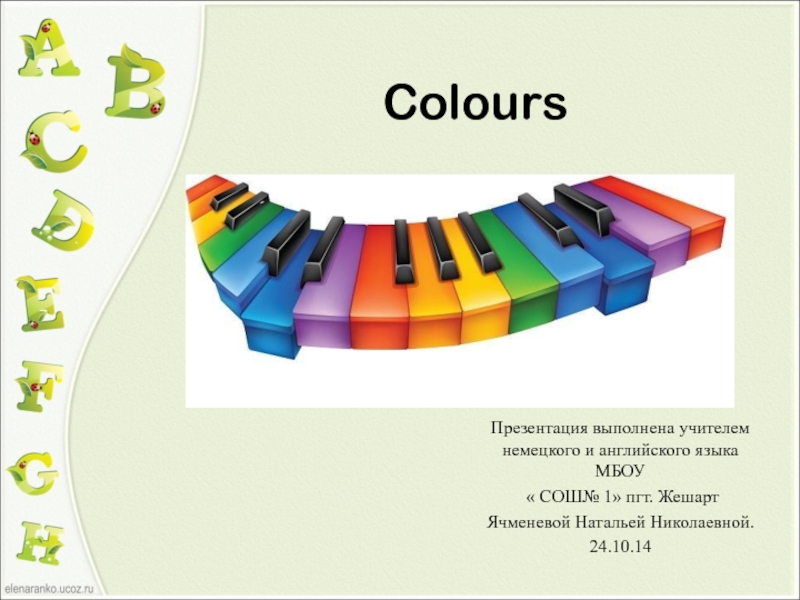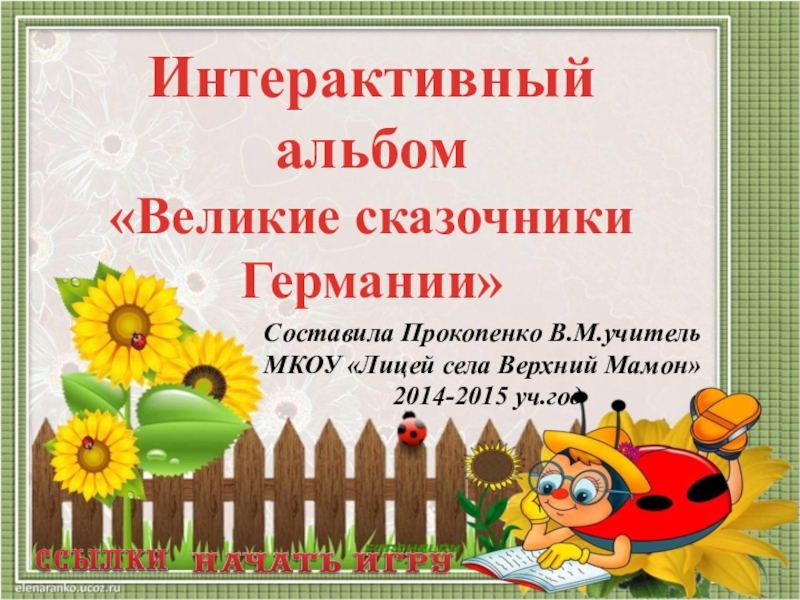Разделы презентаций
- Разное
- Английский язык
- Астрономия
- Алгебра
- Биология
- География
- Геометрия
- Детские презентации
- Информатика
- История
- Литература
- Математика
- Медицина
- Менеджмент
- Музыка
- МХК
- Немецкий язык
- ОБЖ
- Обществознание
- Окружающий мир
- Педагогика
- Русский язык
- Технология
- Физика
- Философия
- Химия
- Шаблоны, картинки для презентаций
- Экология
- Экономика
- Юриспруденция
"Mosaic in Lomonosov's Heritage"
Содержание
- 1. "Mosaic in Lomonosov's Heritage"
- 2. 1.Introducnion2.The history of mosaics3.Lomonosov` interest in mosaic
- 3. Science, Technology, Progress – these words have
- 4. Along with his numerous achievements and discoveries,
- 5. According to the Encyclopedia of Mosaic Techniques,
- 6. We investigated the background of mosaic and
- 7. Mosaic is the art of creating images
- 8. Smalti were made from thick sheets of
- 9. In Acient Egypt the palaces and houses
- 10. The most important piece of Byzantine Christian
- 11. Arabic countries were influenced by the great
- 12. What about Russia? We found out that
- 13. Lomonosov’s interest to mosaic art.M.V.Lomonosov had uncommon
- 14. What is smalti? It is coloured glass
- 15. During his experiments he calculated the
- 16. Lomonosov worked in a tidy ,cramped laboratory
- 17. These lines characterize the situation in which
- 18. Chemical laboratory of coloured glass.
- 19. The first Lomonosov`s mosaic "Нерукотворный Спас" was
- 20. In summer of 1752 he finished his
- 21. Lomonosov`s portraits of mosaic didn`t have equal ones in Europe.
- 22. After that he began doing a mosaic
- 23. His dream was a wide application of
- 24. It surprises by its beauty and size:
- 25. Saint Peter was one of the latest works of Lomonosov
- 26. M.V.Lomonosov’s mosaic portrait commemorating his 300th anniversary
- 27. Слайд 27
- 28. Mosaic as a popular craftMosaic has been
- 29. Слайд 29
- 30. Слайд 30
- 31. The list of used literature1. Андерсон М.
- 32. Скачать презентанцию
1.Introducnion2.The history of mosaics3.Lomonosov` interest in mosaic art4.The first mosaic pictures of Lomonosov5.The Battle of Poltava6.The portrait of Lomonosov made by Andrew Mangeos.7.Conclusion
Слайды и текст этой презентации
Слайд 21.Introducnion
2.The history of mosaics
3.Lomonosov` interest in mosaic art
4.The first mosaic
pictures of Lomonosov
5.The Battle of Poltava
6.The portrait of Lomonosov made
by Andrew Mangeos.7.Conclusion
Слайд 3Science, Technology, Progress – these words have become so common
in our life that we even don`t think over what
great sense they make, what gigantic human work is beyond them. Looking back some centuries ago, we see creators of new thoughts, enthusiasts and devicers who had to discover new ways in science among superstitions and prejudices. One of them is a great Russian scientist, enlightener, and painter M. V. Lomonosov. On November 19, 2011 all progressive mankind marked the 300th anniversary of his birth.Слайд 4Along with his numerous achievements and discoveries, Lomonosov became famous
as the first Russian mosaicist who brought the foundations of
mosaic-marking in our country. He was a great mosaic admirer. Over the last seventeen years of his life he was working at mosaics with a self-forgetful inspiration and exceptional persistence till his death.Слайд 5According to the Encyclopedia of Mosaic Techniques, by Emma Biggs,
“The history of mosaic seems to begin in ancient times
with some of the earliest known piece made with pebbles of contrasting colours coming from Greece .It was the Romans however who really developed the art of mosaic.”The History of Mosaic
Слайд 6We investigated the background of mosaic and found out the
word mosaic translates from Italian as combined from slices. Special
glass tesserae called smalti were manufactured in Italy. Smalti are so firm that the samples dated IV century BC have remained up to nowadays .Mosaic as the way of decorating interior is known from III century BC.Слайд 7Mosaic is the art of creating images with an assemblage
of small pieces of colored glass, stone, or other materials
.
It may be a technique of decorative art, an aspect of interior decoration, or of cultural and spiritual significance as in a cathedral. Small pieces, normally roughly cubic, of stone or glass of different colors, known as tesserae , are used to create a pattern or picture.Слайд 8Smalti were made from thick sheets of coloured glass. Smalti
have a rough surface and contain tiny air bubbles. They
are sometimes backed with reflective silver or gold leaf.The mosaic below is from the ceiling of the baptistery in Florence, Italy.
Слайд 9
In Acient Egypt the palaces and houses of rich people
were decorated with multicoloured stones. In Greece the mosaic was
made from pebbles. Whereas Romans mosaics were mostly used for decorating floors, the Byzentines specialized in covering walls and ceilings. The gold tessarae sparkled as the viewer moved around the building.Слайд 10The most important piece of Byzantine Christian mosaic art is
the Madaba Map, made between 542 and 570 as the
floor of the church of St. George. It is the oldest surviving cartographic depiction of the Holly Land.Слайд 11Arabic countries were influenced by the great tradition of Roman
and early Christian mosaic art. Islamic architecture used mosaic technique
for decorating religious buildings and palaces.Слайд 12What about Russia? We found out that in Russia smalti
appeared in the XI century with the beginning of the
first Christian temples and monasteries. Russian masters studied in Byzantium and smalti were brought from there. But later painting substituted smalti were forgotten almost for six centuries. Interest to this material was revived only in the middle of the 18 century thanks to M.V. Lomonosov.Слайд 13Lomonosov’s interest to mosaic art.
M.V.Lomonosov had uncommon art abilities but
his real talent as a painter opened in mosaic art.
In
1746 the Duke M.I.Vorontsov brought some mosaic pictures from Rome. Lomonosov saw these samples of Italian mosaic and they made great impression on him. He was encouraged by the idea to revive this ancient art in Russia. The Italians closely guarded the secrets. So, Lomonosov decided to develop his own technology of manufacturing of coloured glass.Слайд 14What is smalti? It is coloured glass which is made
up of quartz sand with adding of oxides of different
metals and minerals .Using scientific methods and doing a lot of experiments Lomonosov created the richest palette of paints. From his “Laboratory Register’’ (1751) we learnt that “copper gave real emerald, mercury gave purple glass, iron gave yellow glass, and gold gave ruby.”Слайд 15 During his experiments he calculated the doses of ingredients,
invented tools for cutting glass, metal forms for casting and
also a device to divide smalti to smaller prisms.Слайд 16Lomonosov worked in a tidy ,cramped laboratory .The smoked low
arches were lit up with fire’s reflections of several furnaces,
which smoked very much .In August 1750 Lomonosov sent a letter to Shuvalov in which he wrote:«Воспомяни, что мой покоя дух не знает, Воспомяни мое раченье и труды.
Меж стен и при огне лишь только обращаюсь.
Слайд 17These lines characterize the situation in which he worked. But
difficulties couldn’t stop him. He made over 4000 experiments and
at last created the way of manufacturing smalti of various colours , deep and bright tones. Scientific results of his researches made a great impression abroad. Lomonosov’s smalti sparkling like semi-precious stones, were richer, brighter than Italian. Finishing successfully his experiments he began doing mosaic of big size. So, Lomonosov was mosaic’s inventor in Russia .For his technology he was elected a member of the Bolon Academy of Science in 1764 .He also got a title of a nobleman and an estate 64 km from St. Petersburg, where he set up a glass factory.Слайд 19The first Lomonosov`s mosaic "Нерукотворный Спас" was very simple. Increasing
of palette gave him opportunity to make mosaic, which surpassed
even painting.Слайд 20In summer of 1752 he finished his first work -
mosaic image of Madonna of Italian painter Solimena. He was
making it for 6 months and then presented it to the Empress Elizaveta Petrovna.Слайд 22After that he began doing a mosaic portrait of Peter
the Great. So he created one of the most expressive
and exalted image of Peter. Nowadays this picture is housed in the Hermitage.Слайд 23His dream was a wide application of mosaic in monuments
which could glorify grandeur of Russia and brave deeds of
Russian people. In 1764 he created a grand mosaic picture in honour of Peter the First "The Battle of Poltava“.Слайд 24It surprises by its beauty and size: its length is
6,4m, height is 4,8m and it was made of about
900,000 smalti. Now it decorates the wall of the Academy of Sience in St. Petersburg.Слайд 26M.V.Lomonosov’s mosaic portrait commemorating his 300th anniversary has been madе
in Moscow .
This work of art is the only Lomonosov`s
portrait made not simply in mosaic but of baking enamel.13,650 fragments were used, each of them had been baked like a separate piece of juwellery.The subject of mosaic is symbolic .Great Russian scientist, painter and enlightener M.V. Lomonosov is depicted on the background of his famous mosaic – the Battle of Poltava.
The size of this precious portrait is only 31x41.5 cm but its creation has become a significant event in the history of world science and culture.
This mosaic portrait is a part of the enamel mosaic collection and it is a new art which has no counterparts in the history of the world culture. It was made by mosaicist Andrew Mangeos.
Слайд 28Mosaic as a popular craft
Mosaic has been developed into a
popular craft and art and not limited to professionals. Nowadays
masters work with stone, ceramics, shells, art glass, mirror and even odd items like doll parts, pears or photos. While ancient mosaics tended to be architectural, modern ones are found covering everything from park benches and flowerpots to guitars and bicycles. Items can be as small as an earing or as large as a house. Modern examples of mosaic can be seen on the walls of high buildings at the station of underground.Слайд 31The list of used literature
1. Андерсон М. Петр Великий. Ростов-на-Дону
1997 г.
2. Белявский М. Т. Все испытал и все проник.
М., 1990.3. Вавилов С. И. Михаил Васильевич Ломоносов М. 1961.
4. Данилов А. А. Справочные материалы по истории России IX-XIX веков.
5Идлис Г. М. Революции в астрономии, физике и космологии. М., 1985.
6. Кирилин В. А. Страницы истории, науки и техники. М., 1986.
7. Лебедев Е. Н. Ломоносов. М., 1990.
8. Русские писатели и поэты. Краткий биографический словарь. Москва, 2000.
9. Самин Д. К. 100 великих ученых. – М.: Вече, 2000
10. Шилинский А. Ю., Павлова Г. Е. М. В. Ломоносов – великий русский ученый. М. 1986
11.www.wikipedia.ru
